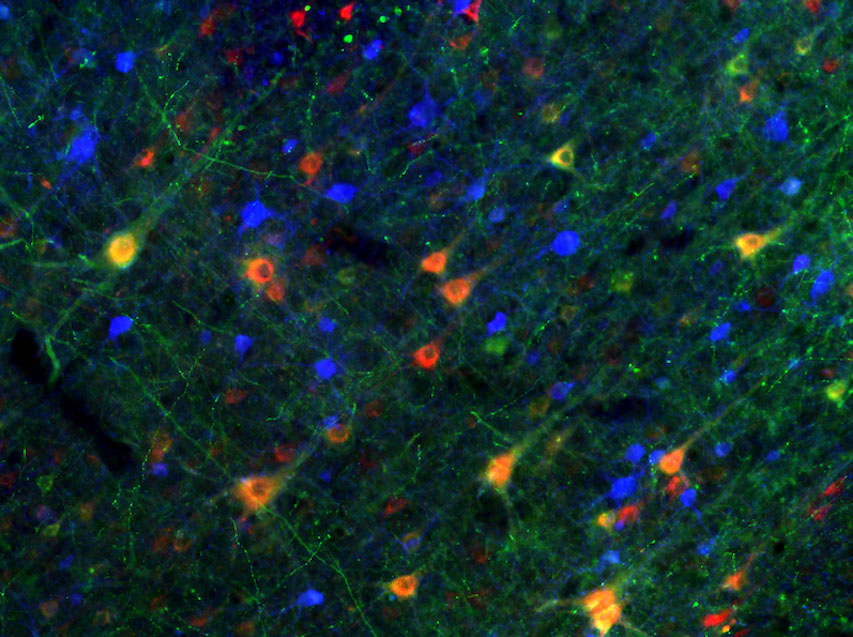How a penalty shootout is decided in the brain
Decision-making is controlled by different nerve cells

Stained nerve cells in the pre-motor cortex of a rhesus monkey. © Michal Fortuna
/DPZ/ A penalty shootout at the Soccer World Cup. All eyes are on the best striker of the team. He should take the decisive shot, preferably past the goalkeeper. The striker must decide whether to aim for the right or left corner of the goal. In his brain, he plans both options before making the decision. If the goalkeeper’s posture indicates that he will jump to the right at the decisive moment, the striker will develop a temporary preference for planning a movement to the left corner. But what effect will this tendency have on the final decision if the goalkeeper changes his posture just before the shot? Will the striker still shoot to the left? And how is this process controlled at the level of the nerve cells? Neuroscientists at the German Primate Center (DPZ) – Leibniz Institute for Primate Research in Göttingen have investigated these questions in a study with rhesus monkeys. They were able to show that two different nerve cell types in the same brain area are responsible for the decision-making process. A preliminary tendency for an action plan influences the final decision and the weighing of both options is already visible on the neuronal level. The striker is therefore likely to shoot to the left even if the goalkeeper suddenly changes his posture – and the penalty may fail (eLife).
The scientists have trained two rhesus monkeys to perform a task on a screen. At the same time, the activity of the nerve cells in their brain was measured. Circular signals appeared on the touch screen the monkeys should touch. The circles appeared on the right or left, at the top or bottom of the screen. The place where they appeared was random, but the monkeys received a hint in the form of small arrows where the next signal could appear. For example, if there was a large purple arrow pointing to the left and a small blue arrow pointing to the right at the same time, it was more likely that the signal would appear on the left. However, this expectation was violated every now and then by the signal appearing exactly opposite the previously indicated direction or by both signals appearing simultaneously on the right and left, which could then be freely selected.
The researchers observed that the monkeys developed a tendency towards the direction indicated by the arrows previously shown. If the signal appeared on the expected side, they solved the task correctly and quickly. If, contrary to expectations, the signal appeared on the opposite side, the reaction times increased and the monkeys made more mistakes. If the animals had the free choice, they preferred in most cases those signals, which appeared on the before indicated side, even if both possibilities were objectively considered equivalent.
“A preliminary action tendency influences subsequent decisions, even if the facts change in the meantime,” says Lalitta Suriya-Arunroj, first author of the study. “Even though the monkeys had a free choice, they opted for their provisional plan of action. The striker in front of the goal has a similar situation. He sees that the goalkeeper wants to jump to the right and plans the left corner first. Even if the goalkeeper takes a neutral posture at the last moment, in most cases he will keep this direction and the penalty kick may be intercepted.”
At the level of nerve cells, the scientists were also able to make a new discovery: Decision-making and the weighing between several action alternatives are mapped as a dual process on the neuronal level. Two different types of nerve cells are responsible for this. The first group is responsible for coding the preferred target. As long as there is no tendency, they are not active, they only fire when a preference for an action option arises. The stronger the tendency for this option, the more active the cells become. The second group of nerve cells shows all given alternatives from the beginning. It is decided which of the options for action is out of the question. The nerve cells that code for the non-preferred option are the more strongly down-regulated the less the option is considered. According the choice-by-elimination principle, the option that represents the best choice remains.
“The fact that two different nerve cells in the same brain area are responsible for the decision-making process is a new finding of this study,” says Alexander Gail, head of the sensorimotor research group at the DPZ and also author of the study. “The planning in the brain is thus controlled by a dual process that reflects strong tendencies to act as well as all other possibilities that can be eliminated one after the other by the choice-by-elimination principle. Thus, the brain enables us to make balanced and flexible decisions. The striker in front of the goal, despite his first preference, is thus able not to immediately exclude the other corner of the goal as an option, can change the direction of the shot at the last moment and thus possibly still score a goal.”
Original publication
Suriya-Arunroj L, Gail A (2019): Complementary encoding of priors in monkey frontoparietal network supports a dual process of decision-making. eLife 8:e47581, doi: 10.7554/eLife.47581




